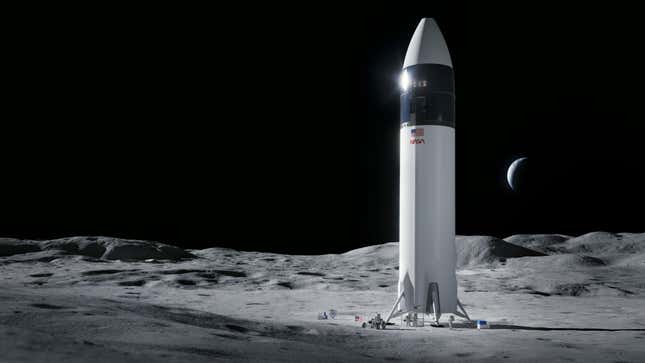
SpaceX has won a lucrative NASA contract to build the first lunar lander since the Apollo program. The announcement comes as a big surprise, as the Elon Musk-led company beat out a pair of promising competitors, including Jeff Bezos’s Blue Origin.
Sorry Blue Origin and Dynetics, but SpaceX will have the privilege of putting its logo on the next Moon lander, as NASA announced at a press conference today. The move highlights NASA’s growing trust in its commercial partner, as the space agency prepares to return astronauts to the Moon for the first time since 1972.
“This is a gutsy, and risky, choice by NASA,” Jonathan McDowell, an astrophysicist at the Harvard-Smithsonian Center for Astrophysics, told me via Twitter. “If Starship works as planned, it will provide a lot more capability than the other entrants. But that’s a significant if.”
The chance that Starship won’t actually work “is significantly higher than the more traditional options,” he wrote.
McDowell is right—this was not the safe choice. A vertically landing rocket, as opposed to a 1960s-style lunar lander, is something that’s never been tried before. By making this decision, it’s clear that NASA is looking to the future and ongoing innovation in this area.
That the space agency was looking to the private sector to design and build a Human Landing System (HLS) was already known. NASA handed out $967 million to the three firms to come up with a lander for the upcoming Artemis Moon missions. But NASA didn’t allocate these funds evenly, giving Blue Origin $579 million, the Alabama-based Dynetics $243 million, and SpaceX a seemingly token amount of $135 million.
The Blue Origin bid seemed like the leading candidate. Blue Origin, in addition to receiving the lion’s share of NASA funding, partnered with three major companies in a bid to make this happen: Lockheed Martin, Northrop Grumman, and Draper. Blue Origin, led by Amazon CEO Jeff Bezos, even delivered a full-scale mockup of its solution, called the Integrated Lander Vehicle, to NASA in August of last year. NASA’s decision to go with SpaceX will likely come as a blow to Bezos, who says he’s been fascinated by the Moon ever since he watched the Apollo landings as a young child.
SpaceX will use its upcoming Starship platform for the lunar landings. The vehicle will include a large cabin and two airlocks for astronaut moonwalks. Importantly, it’s also reusable. The newly awarded contract is for $2.89 billion, and under the terms of this milestone-based agreement, SpaceX will have to demonstrate an uncrewed lunar landing test flight, as Mark Kirasich, deputy associate administrator for NASA’s Advanced Exploration Systems division, explained during the press conference.
Kathy Lueders, associate administrator for NASA’s Human Exploration and Operations Mission Directorate, didn’t provide details about why SpaceX was chosen over the other bids, saying the decision is “part of an overall, larger strategy” for going to the Moon in a sustainable way. SpaceX was the best option “at this point,” and NASA will now open discussions with other commercial partners for follow-up competitions. “This is the first step,” said Lueders.
Acting NASA Administrator Steve Jurczyk was more forthcoming, saying competitors were chosen based on criteria having to do with technical cost, feasibility, and management approach. While SpaceX was chosen for the initial landing demonstration, the NASA officials made it clear that other commercial partners will be involved as the project advances, adding that sustainability will a key factor moving forward. Blue Origin and Dynetics, it would seem, may still have an important role to play after SpaceX’s pending tech demo.
At today’s press conference, HLS program manager Lisa Watson-Morgan said NASA’s upcoming Space Launch System remains a critical component of Artemis. The gigantic rocket will deliver the Orion capsule—along with its crew—to a predetermined rendezvous point in lunar orbit. Ideally, this point will be NASA’s Lunar Gateway, a permanent lunar outpost that still needs to be built. There, the crew will exit Orion and enter into the SpaceX HLS. The crew will then land on the Moon, perform their duties, return to Starship, and head back to the outpost.
As for SpaceX, it will launch a Starship from Earth, refuel the vehicle in low Earth orbit, deliver the HLS to the rendezvous point, and have it wait for the Artemis crew. Strangely, SpaceX was not involved in today’s press conference.
Starship prototypes are currently being tested at SpaceX’s Boca Chica test facility in Texas. These tests appear to be going relatively well, particularly the launch aspects, but the company has yet to land the rocket without it exploding in a huge fireball. Elon Musk expects the next generation of Starship prototypes, beginning with the upgraded SN15 (currently on the launch pad at Boca Chica), to perform better than the earlier versions.
The new contract is “a big triumph for SpaceX” and “shows the confidence that NASA has gained in the company while working with them on Falcon 9 payload launches and then on Crew Dragon,” said McDowell.
Kirasich said 2024 is still the goal for a crewed landing on the Moon. Given the importance of Lunar Gateway to the mission architecture, however, this target seems increasingly implausible.
Under the Trump administration, NASA was told to return astronauts to the Moon by 2024, but President Biden has not yet committed to this ambitious date (his team is currently working on a new timeline), despite committing to the Artemis program itself. Excitingly, the Biden administration has also committed to sending a woman and man to the Moon, and also the first person of color.
More: Artemis Astronauts Will Be Doing Some Serious Science on the Moon